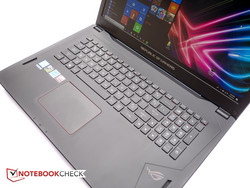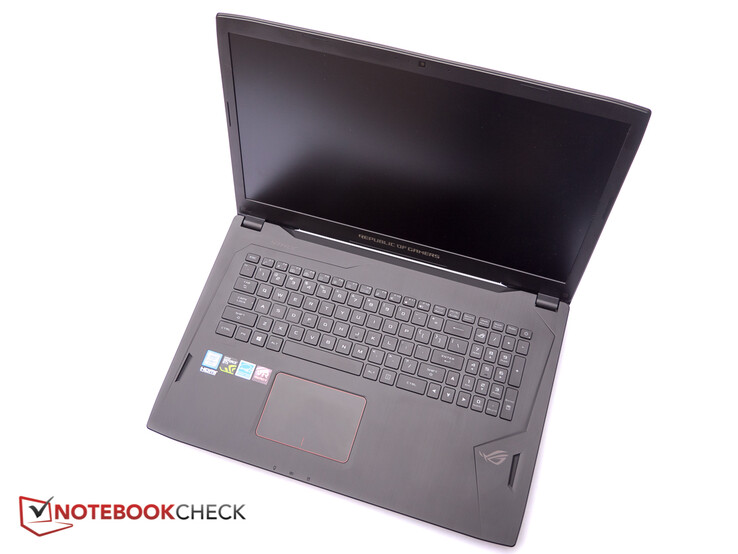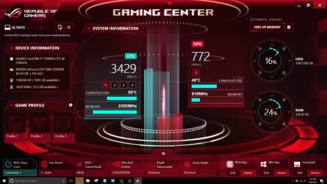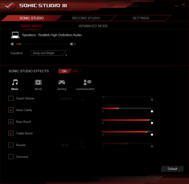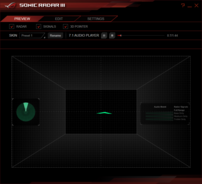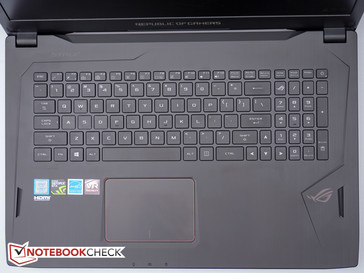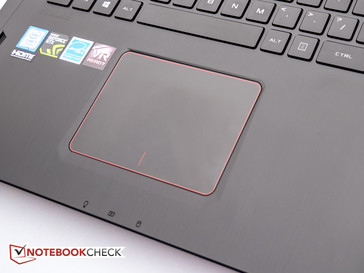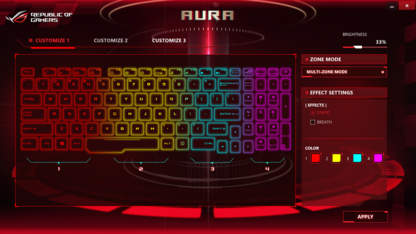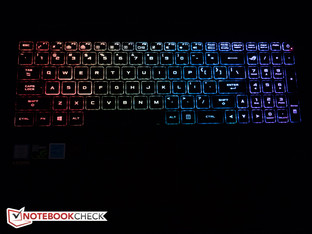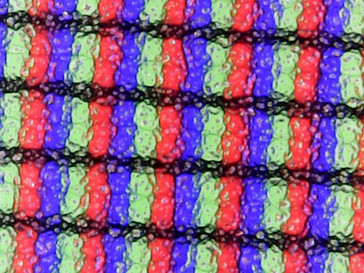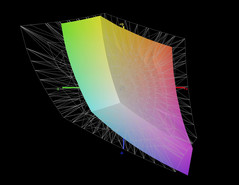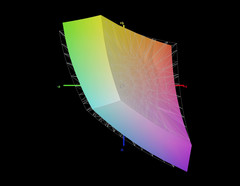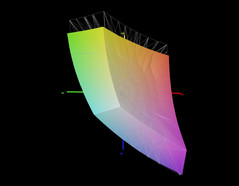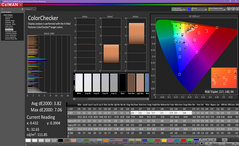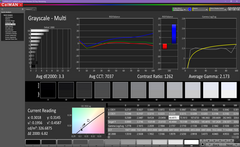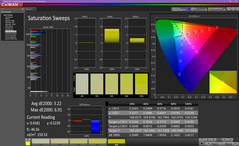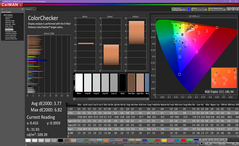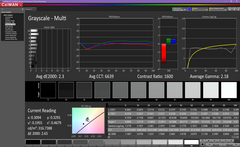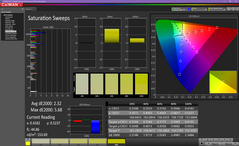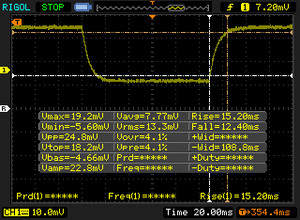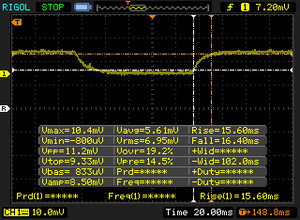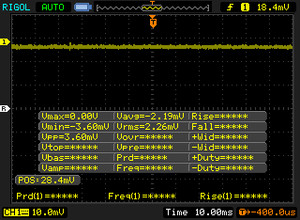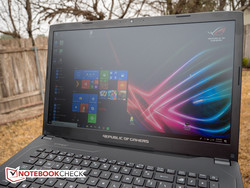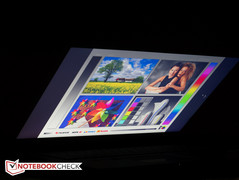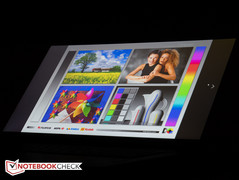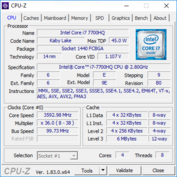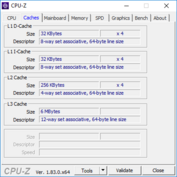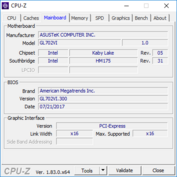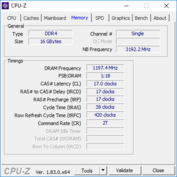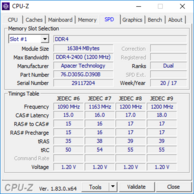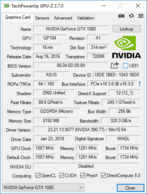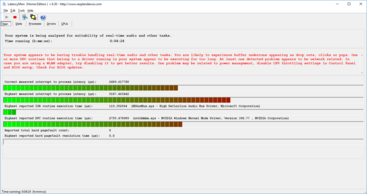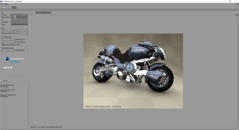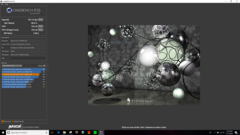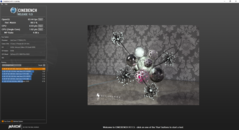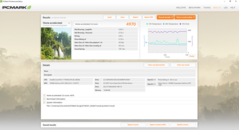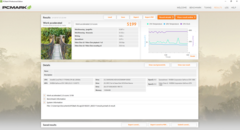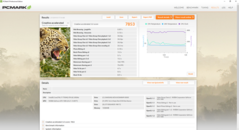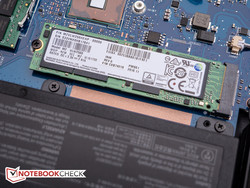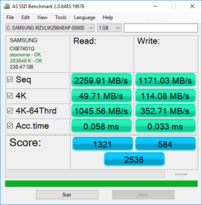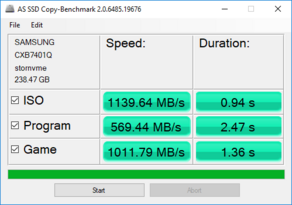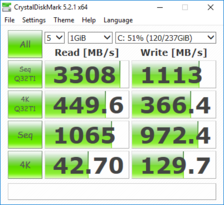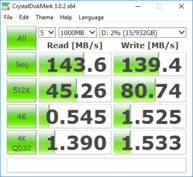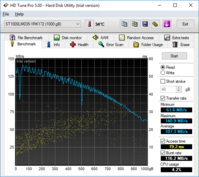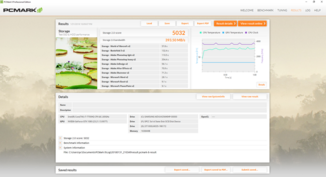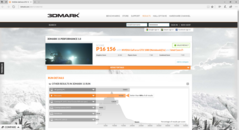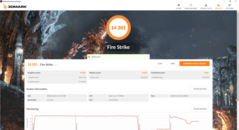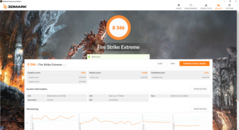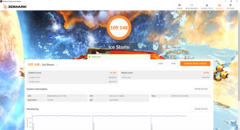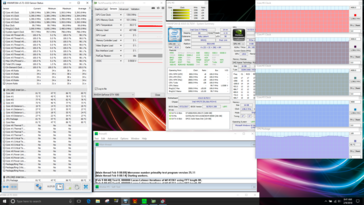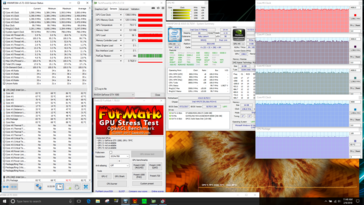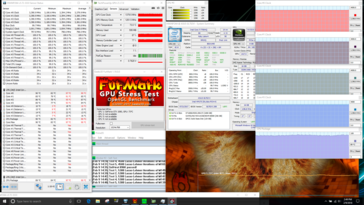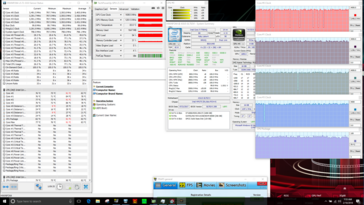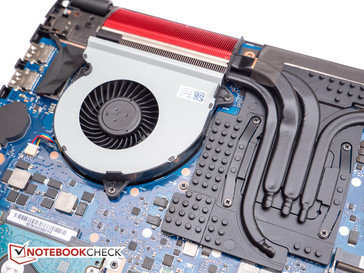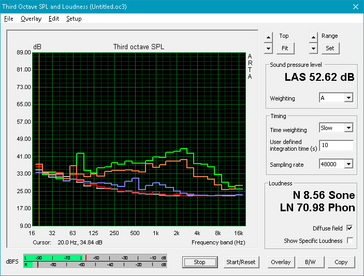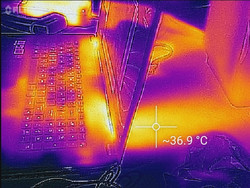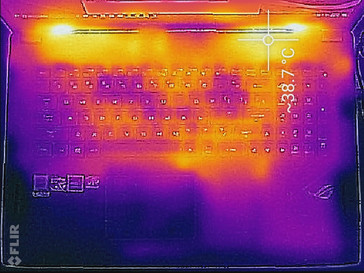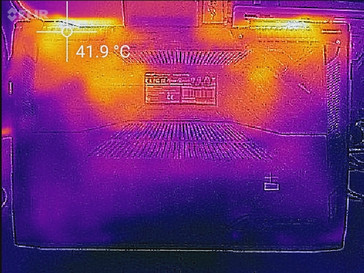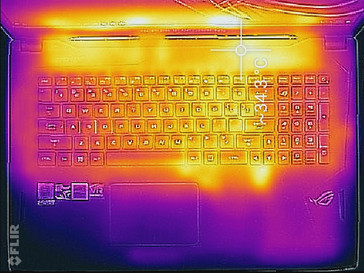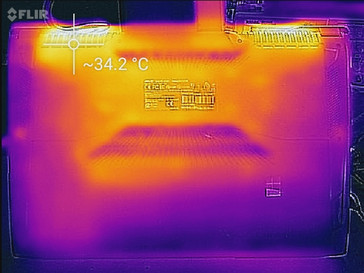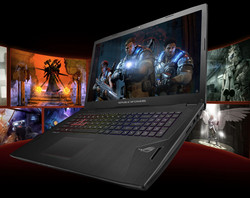Asus ROG Strix GL702VI (i7-7700HQ, GTX 1080) Laptop Review
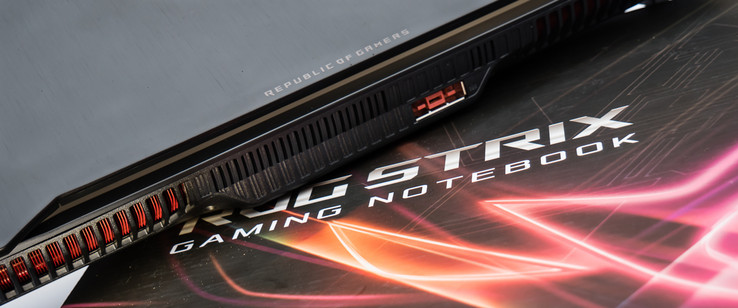
Asus' ROG Strix series of gaming laptops targets the mainstream-to-premium segment and really needs no further introduction. The 17.3-inch ROG Strix GL702VI-WB74 is far removed from mainstream though, as it packs some serious power: a 7th-generation Intel quad-core CPU, 16 GB of RAM, SSD plus HDD, and a high-end Nvidia GeForce GTX 1080 graphics card add up to an overall very pleasing gaming performance. At the time of writing, our review notebook sells for $1900 from our supplier CUKUSA (Computer Upgrade King), which seems almost like a bargain, given that some competitors in this realm easily surpass $3000.
We've already encountered other notebooks in the GL702-series, namely the GL702VM (6700HQ, FHD, GTX 1060), GL702VS (7700HQ, FHD, GTX 1070) and the GL702ZC (Ryzen 7 1700, Radeon RX 580), so we encourage our readers to take a look at these review for additional information and viewpoints. For our comparison, we'll take a look at other gaming rigs like the Alienware 17 R4, Acer Predator 17 X, and the MSI GT75VR 7RF Titan Pro, among others.
Case
Asus uses a mix of materials for the construction of the GL702VI. While the body consists of plastic, the back of the display is made from brushed metal with a hairline texture finish and adorned with the prominent chrome-colored Asus logo and two angled accent stripes, both of which start glowing red when the laptop is turned on. The plastic on the keyboard deck features the same texture as the lid, while the bottom shell is made of much rougher plastic - a benefit in this case, as fingers won't slip easily when carrying the unit. Speaking of carrying: fingerprints are an issue on both the lid and the deck, but removing them is much less tedious then it is on other laptops. Stability and build quality are a mixed bag: while the chassis itself resists flex very well with only minor creaking sounds and features tight tolerances, the display appears to be much less well put together with uneven gaps around the bezel. The lid twists easily and creaks audibly during the process; even moderate pressure on the back leads to ripple effects and discoloration up front. The keyboard deck flexes noticeable as well - particularly in the area between the main section and the number pad - although this should only affect very heavy-handed typists. Laptops like the more expensive Alienware 17 R4 feature much better build quality along with soft-touch rubberized surfaces and upscale, higher-end materials.
The hinges are stiff enough to hold the display in any position up to the maximum opening angle of about 135 degrees with no noticeable wobbling while typing. Moving the laptop around or prodding the panel will introduce bouncing, but this is not likely to occur since a gaming laptop normally remains stationary on the user's desk.
As far as the styling goes, Asus definitely uses a more "in-your-face" approach here compared to the more subdued and understated Asus ROG Strix GL703VD or the Razer Blade Pro 2017, both of which could even make an appearance in a boardroom without raising eyebrows. In addition to the aforementioned light-up logos and accent stripes, the heat sinks are bright red as well and visible when looking at the machine from the rear. For better or worse, it's hard to look at the GL702VI and not immediately recognize its intended audience.
At first glance it's quite obvious that the GL702VI isn't one of the new, svelte-looking gaming laptops - like the astronomically expensive Razer Blade Pro - designed for maximum thinness. From a footprint perspective, the notebook is actually not that large and it's not nearly as deep as many competitors like the Alienware 17 R4 or the Acer Predator 17 X, but it is comparatively thick at 37 mm. Then again, laptops with desktop processors like the Schenker XMG U727 are larger in every dimension and heavier as well. Our review notebook tips the scale at 3.2 kg / 7 lbs; the gargantuan power supplies adds an additional 1.44 kg / 3.2 pounds - as much as some Ultrabooks - so the all-up weight is north of 10 lbs. Needless to say that most users likely won't be using the GL702VI as their mobile companion, so the added heft isn't necessarily detrimental.
Connectivity
Given the physical size of this notebook, we'd call the selection of physical ports adequate - many competing gaming notebooks offer additional or update, more modern ports. Connectivity is similar to that of the Asus Strix GL702VS Xotic PC Edition - with one major exception: while the GL702VS is equipped with a Thunderbolt 3 port, our review notebook features a simple USB Type-C USB 3.1 (Gen1) port, which tops out at at a paltry 5 Gbps. Given the powerful graphics card, which will likely keep most users happy for some time to come, we would've preferred it had Asus included a Thunderbolt 3 port as well to provide an additional measure of future readiness. Still, most users will find the port selection adequate. Most of the ports on Strix GL702 are on the left-hand side as well as behind the mid-line, so right-handers at least won't have to worry about cables getting into the way of mouse operation. Note that the AC power port has been moved to the back - a good decision, as the connector is huge by any standard.
SD Card Reader
AS SSD attests the spring-loaded card reader on the right edge transfer rates of about 90 MB/s; a copy of 1 GB of jpeg files (about 5 MB each) from our Toshiba Exceria Pro SDXC 64 GB UHS-II reference card to the desktop takes place at 71 MB/s and thus just under 15 seconds. Judging by the recorded and fairly middling speeds, the card reader utilizes a USB 3.0 interface - the GL702VI is in good company here, although some gaming notebooks like the Aorus X7 v7 are significantly faster.
| SD Card Reader | |
| average JPG Copy Test (av. of 3 runs) | |
| Aorus X7 v7 (Toshiba Exceria Pro SDXC 64 GB UHS-II) | |
| SCHENKER XMG U727 2017 (Toshiba Exceria Pro SDXC 64 GB UHS-II) | |
| Average of class Gaming (19 - 202, n=100, last 2 years) | |
| Acer Predator 17 X GX-792-76DL (Toshiba Exceria Pro SDXC 64 GB UHS-II) | |
| Asus ROG Strix GL702VI-WB74 | |
| Asus ROG Strix GL703VD-DB74 (Toshiba Exceria Pro SDXC 64 GB UHS-II) | |
| Razer Blade Pro 2017 (Toshiba Exceria Pro SDXC 64 GB UHS-II) | |
| maximum AS SSD Seq Read Test (1GB) | |
| Aorus X7 v7 (Toshiba Exceria Pro SDXC 64 GB UHS-II) | |
| SCHENKER XMG U727 2017 (Toshiba Exceria Pro SDXC 64 GB UHS-II) | |
| Average of class Gaming (26 - 269, n=93, last 2 years) | |
| Asus ROG Strix GL702VI-WB74 | |
| Acer Predator 17 X GX-792-76DL (Toshiba Exceria Pro SDXC 64 GB UHS-II) | |
| Asus ROG Strix GL703VD-DB74 (Toshiba Exceria Pro SDXC 64 GB UHS-II) | |
| Razer Blade Pro 2017 (Toshiba Exceria Pro SDXC 64 GB UHS-II) | |
Communication
Our review notebook is equipped with the Intel 8265 Tri-Band WiFi card, which supports the standards a/b/g/n/ac as well as Bluetooth 4.1. The transmit and receive speeds - established one meter away from our Linksys EA8500 reference router - are just average at 470 and 587 Mbit/s, respectively. Most upper-class gaming notebooks are equipped with Killer wireless cards along with the renowned Killer Control Center software suite, which allows the user to configure the network card.
In addition, the notebook sports Realtek RTL8168B/8111B (10/100/1000MBit) network card for wired connections.
Software
The pre-installed software includes the ROG Gaming Center, which allows the user to monitor system information like the temperature and fan speed, Sonic Studio, which offers in-game noise cancellation, volume stabilization, as well as Sonic Radar, which is supposed to help detect opponents by displaying the position of gunshots, footsteps, and other sound effects.
Accessories
The colorful box contains the notebook, the 330 W power adapter, a microfiber cloth, a couple of pamphlets, and an Asus-branded cable tie.
Maintenance
A total of 10 Phillips screws have to be removed in before the bottom plate can be pried off, as there is no dedicated maintenance hatch. While the internal hooks retain the plate quite securely, a tool like an old credit card makes the job much easier and a rather painless affair. Once the panel is removed, the user gains access to the two DDR4 SODIMM slots (one occupied), the M.2 SSD, the 2.5-inch HDD, the WLAN-module as well as the two system fans, which . The battery is easy to access as well should a replacement become necessary.
Warranty
Asus warrants its notebooks against manufacturers defects for a period of 12 months, which also includes a one-year international warranty service, a 30 day Zero Bright Dot Guarantee, 24/7 technical support and free 2-way standard shipping.
Please see our Guarantees, Return Policies and Warranties FAQ for country-specific information.
Input Devices
Keyboard
The Asus ROG Strix GL702VI is equipped with a four-zone, backlit keyboard (3 brightness levels + off) with chiclet-style keys and visually different WASD keys. Typing is generally pleasant with decent feedback and a reasonably well-defined pressure point. According to Asus, the keys features scissor switches and 1.8 mm of travel. Keyboard clatter is very minimal and unobtrusive enough even in very quiet environments. As we mentioned earlier, there's some flex across the deck when pressure is applied and the smaller 12 mm keys in the dedicated number block in particular feel maybe a smidgen softer when depressed. The backlight is customizable and can be adjusted across the four zones. Gaming aficionados might miss the lack of dedicated macro keys, however. We are also not a fan of the location of the power switch, which is integrated in the function key row on the far right next to the PgDn-button and thus fairly easy to hit by accident.
Note that the Asus ROG Strix GL703VD-DB74 features a more modern gaming-centric keyboard layout with a wider space bar on the left side and three of the four arrow keys sitting below the keyboard to improve ergonomics while gaming. The GL703VD also has four dedicated buttons on the left above the function key row - on the review notebook, these buttons are integrated into the function key row and the number pad, which leads to a much more cramped experience overall.
Touchpad
The clickpad utilizes Windows 10 precision drivers, measures about 10.4 x 7.3 cm (4.1 x 2.9 in) and does its job reasonably well as far as cursor control as well as gestures are concerned. Fingers glide easily on the smooth surface, although moist fingers tend to stick somewhat. Response can be intermittent at the very left and right edges; in addition, left and right clicks are occasionally interpreted as movement if the finger isn't perfectly still. The integrated left- and right-click buttons feature average travel with good and audible, but hollow-sounding feedback. We much prefer dedicated mouse buttons as found on the Alienware 17 R4 or the Acer Predator 17 X. Right-clicking can also be accomplished by using a two-finger press. While the touchpad might suffice for normal daily tasks, we definitely recommend the use of an external mouse for gaming.
Display
Display choices are restricted to two different anti-glare IPS panels: both feature FHD resolution and G-Sync, but the refresh rate is 60 Hz in one case and 120 Hz in the other. Our review notebook is equipped with latter panel from AU Optronics (type B173HAN01.1). 1920 x 1080 pixels isn't all that much considering the screen real estate and many laptops offer UHD and QHD panels as options and subsequently much higher pixel densities. Given that the GL702VI is equipped with a high-end graphics card, we would've liked to see a 4K panel as an option. Asus doesn't make any claims as far as the brightness is concerned, but according to our measurements with the X-Rite spectrophotometer, on average the panel provides is just under 310 nits, which is decent, but not great. Most notebooks - including Asus' own ROG Strix GL703VD-DB74 - are a bit brighter. The contrast ratio of about 1000:1 is also quite acceptable - most TN displays don't perform nearly as well.
Although the refresh rate is fast at 120 Hz, the black-white response time of about 15.2 ms can't hold a candle compared to laptops equipped with faster TN displays like the MSI GT75VR 7RF Titan Pro, which comes in at just under 5 ms. Still, the general operating experience is silky-smooth and responsive. The anti-glare coating only contributes to a fairly minor amount of graininess, but unfortunately, our panel suffers from major backlight bleeding particularly in the lower left and upper right corners, which can be very distracting when displaying darker backgrounds while gaming. While minor backlight bleeding is not uncommon at all with panels based on IPS technology, our particular example is one of the worst offenders we have seen in a while. At this point, we can't say if this affects all the notebooks in this series our just our particular review sample.
| |||||||||||||||||||||||||
Brightness Distribution: 92 %
Center on Battery: 312.9 cd/m²
Contrast: 1009:1 (Black: 0.31 cd/m²)
ΔE Color 3.82 | 0.5-29.43 Ø5
ΔE Greyscale 3.3 | 0.57-98 Ø5.3
87.4% sRGB (Argyll 1.6.3 3D)
62.3% AdobeRGB 1998 (Argyll 1.6.3 3D)
62.6% AdobeRGB 1998 (Argyll 2.2.0 3D)
87.4% sRGB (Argyll 2.2.0 3D)
61.7% Display P3 (Argyll 2.2.0 3D)
Gamma: 2.18
| Asus ROG Strix GL702VI-WB74 AU Optronics B173HAN01.1, IPS, 17.30, 1920x1080 | Acer Predator 17 X GX-792-76DL LP173WF4-SPF5 (LGD056D), IPS, 17.30, 1920x1080 | SCHENKER XMG U727 2017 AU Optronics B173ZAN01.0 (AUO109B), AHVA, 17.30, 3840x2160 | Alienware 17 R4 TN LED, 17.30, 2560x1440 | Aorus X7 v7 AU Optronics B173QTN01.4 (AUO1496), TN LED, 17.30, 2560x1440 | Asus ROG Strix GL703VD-DB74 LG Philips LP173WF4-SPF5, IPS, 17.30, 1920x1080 | Razer Blade Pro 2017 Sharp LQ173D1JW33 (SHP145A), IGZO, 17.30, 3840x2160 | |
|---|---|---|---|---|---|---|---|
| Display | 0% | 38% | -3% | 1% | 3% | 39% | |
| Display P3 Coverage | 61.7 | 66 7% | 86.6 40% | 61.2 -1% | 63 2% | 67.6 10% | 88.9 44% |
| sRGB Coverage | 87.4 | 83.7 -4% | 99.9 14% | 82.9 -5% | 87.1 0% | 86.1 -1% | 100 14% |
| AdobeRGB 1998 Coverage | 62.6 | 61.2 -2% | 99.5 59% | 60.5 -3% | 63.7 2% | 62.9 0% | 99.7 59% |
| Response Times | -21% | -20% | 30% | 52% | 15% | -65% | |
| Response Time Grey 50% / Grey 80% * | 32 ? | 45 ? -41% | 44 ? -38% | 30 ? 6% | 24 ? 25% | 30.8 ? 4% | 60.8 ? -90% |
| Response Time Black / White * | 27.6 ? | 28 ? -1% | 28 ? -1% | 12.8 ? 54% | 6 ? 78% | 20.4 ? 26% | 38.4 ? -39% |
| PWM Frequency | 119000 ? | 204.9 ? | |||||
| Screen | -4% | 15% | -24% | -29% | -10% | -10% | |
| Brightness middle | 312.9 | 380 21% | 362 16% | 402.3 29% | 375 20% | 421.2 35% | 230 -26% |
| Brightness | 308 | 362 18% | 344 12% | 372 21% | 353 15% | 393 28% | 207 -33% |
| Brightness Distribution | 92 | 91 -1% | 85 -8% | 86 -7% | 85 -8% | 85 -8% | 83 -10% |
| Black Level * | 0.31 | 0.37 -19% | 0.35 -13% | 0.62 -100% | 0.58 -87% | 0.44 -42% | 0.2 35% |
| Contrast | 1009 | 1027 2% | 1034 2% | 649 -36% | 647 -36% | 957 -5% | 1150 14% |
| Colorchecker dE 2000 * | 3.82 | 4.12 -8% | 2.46 36% | 5.6 -47% | 6.06 -59% | 5 -31% | 5.62 -47% |
| Colorchecker dE 2000 max. * | 7.06 | 8.19 -16% | 4.26 40% | 9.8 -39% | 10.54 -49% | 8.8 -25% | 10.24 -45% |
| Greyscale dE 2000 * | 3.3 | 3.95 -20% | 2.9 12% | 4.7 -42% | 5.68 -72% | 5 -52% | 4.54 -38% |
| Gamma | 2.18 101% | 2.47 89% | 2.31 95% | 2.14 103% | 2.3 96% | 2.18 101% | 2.36 93% |
| CCT | 7037 92% | 6539 99% | 6120 106% | 7519 86% | 7998 81% | 6882 94% | 6625 98% |
| Color Space (Percent of AdobeRGB 1998) | 62.3 | 55 -12% | 88 41% | 53.7 -14% | 57 -9% | 62.94 1% | 88 41% |
| Color Space (Percent of sRGB) | 87.4 | 84 -4% | 100 14% | 82.2 -6% | 87 0% | 86.1 -1% | 100 14% |
| Total Average (Program / Settings) | -8% /
-5% | 11% /
15% | 1% /
-13% | 8% /
-12% | 3% /
-4% | -12% /
-7% |
* ... smaller is better
Color space coverage is decent at 87 and 62 percent of the sRGB and AdobeRGB standards with most higher gaming notebooks not offering a noticeably better color gamut. The exception here is the Schenker XMG U727, as its 4K panel plays in a different league altogether and does a much better job with the professional color spaces. While we can't recommend the GL702VI for serious graphic or video editing, occasional photo editing is definitely not out of the question.
Our measurements with an X-Rite spectrophotometer show relatively accurate grayscale and color as shipped. A quick calibration unfortunately has a negligible effect and colors in particular do not improve at all. Blue becomes increasingly inaccurate at higher saturation levels, but it's difficult to see the effect with the naked eye.
Display Response Times
| ↔ Response Time Black to White | ||
|---|---|---|
| 27.6 ms ... rise ↗ and fall ↘ combined | ↗ 15.2 ms rise | |
| ↘ 12.4 ms fall | ||
| The screen shows relatively slow response rates in our tests and may be too slow for gamers. In comparison, all tested devices range from 0.1 (minimum) to 240 (maximum) ms. » 66 % of all devices are better. This means that the measured response time is worse than the average of all tested devices (21.5 ms). | ||
| ↔ Response Time 50% Grey to 80% Grey | ||
| 32 ms ... rise ↗ and fall ↘ combined | ↗ 15.6 ms rise | |
| ↘ 16.4 ms fall | ||
| The screen shows slow response rates in our tests and will be unsatisfactory for gamers. In comparison, all tested devices range from 0.2 (minimum) to 636 (maximum) ms. » 36 % of all devices are better. This means that the measured response time is similar to the average of all tested devices (33.7 ms). | ||
Screen Flickering / PWM (Pulse-Width Modulation)
| Screen flickering / PWM not detected | |||
In comparison: 53 % of all tested devices do not use PWM to dim the display. If PWM was detected, an average of 17924 (minimum: 5 - maximum: 3846000) Hz was measured. | |||
While we can't be sure how many users actually venture outside with their gaming notebooks, outdoor visibility is nonetheless acceptable in the shade and heavily overcast conditions. While the brightness should be higher than 310 nits to overcome direct sunlight, it's still surprising how well this large screen remains readable in the shade. Glossy panels are at a distinct disadvantage, as are panels based on TN technology because of their inferior contrast. Viewing angle stability is also quite good with no major color changes or darkening and shallow angles.
Performance
Our review unit is powered by the - at least in the world of gaming notebooks - ubiquitous Intel Core i7-7700HQ processor, a powerful Nvidia GeForce GTX 1080, 16 GB of RAM, a 256 GB SSD and a 1 TB HDD. Computer Upgrade King sells various (fairly inexpensive) upgrades: switching to a 512 GB SSD costs $95; an additional 16 GB of RAM cost $160. With a 1 TB M.2 NVMe SSD, 2 TB HDD, and 32 GB of RAM, the laptop tops out at just over $2300.
The Strix makes use of Nvidia's G-Sync technology, so naturally, Nvidia Optimus is not supported.
Processor
The ROG Strix GL702VI is equipped with a quad-core Intel Core i7-7700HQ with a TDP of 45 W and base clock of 2.8 GHz with Turbo boost up to 3.8 GHz. In addition, Asus also offers the notebook with a lower-end Intel Core i5 7300HQ CPU. Many high-end competitors feature the i7-7820HK, which is one of the fastest mobile Kaby Lake CPUs out there. The result of 723 points for Cinebench R15 Multi is slightly lower than we expected it to be but not worryingly so; the higher-end i7-7820HK outperforms the i7-7700HQ by roughly 20 %. Users opting for a Core i5-7300HQ processor can expect a performance decrease of roughly 30 percent. Note though that the i7-7700HQ isn't really a bottleneck while gaming, so the faster and more expensive CPUs offered by other manufacturers might not actually yield major benefits.
Sustained performance is very good: after an initial and very minor drop, the GL702VI keeps going with no apparent degradation even towards the end of the Cinebench R15 loop test (50 iterations).
For more information about the Intel Core i7-7700HQ and additional benchmarks, please visit our dedicated processor page.
| Cinebench R15 | |
| CPU Single 64Bit | |
| Average of class Gaming (79.2 - 318, n=230, last 2 years) | |
| SCHENKER XMG U727 2017 | |
| Acer Predator 17 X GX-792-76DL | |
| Alienware 17 R4 | |
| Aorus X7 v7 | |
| Razer Blade Pro 2017 | |
| Average Intel Core i7-7700HQ (120 - 162, n=110) | |
| Lenovo Legion Y520-15IKBM 80YY001APB | |
| Asus ROG Strix GL702VI-WB74 | |
| CPU Multi 64Bit | |
| Average of class Gaming (400 - 5663, n=231, last 2 years) | |
| SCHENKER XMG U727 2017 | |
| Acer Predator 17 X GX-792-76DL | |
| Alienware 17 R4 | |
| Aorus X7 v7 | |
| Razer Blade Pro 2017 | |
| Average Intel Core i7-7700HQ (603 - 747, n=111) | |
| Asus ROG Strix GL702VI-WB74 | |
| Lenovo Legion Y520-15IKBM 80YY001APB | |
| wPrime 2.10 - 1024m | |
| Asus ROG Strix GL702VI-WB74 | |
| Lenovo Legion Y520-15IKBM 80YY001APB | |
| Average of class Gaming (116.8 - 1021, n=13, last 2 years) | |
| Average Intel Core i7-7700HQ (210 - 379, n=48) | |
| Alienware 17 R4 | |
* ... smaller is better
System Performance
System performance according to the PCMark benchmarks falls slightly behind comparably-equipped competing notebooks. Application launches happen very quickly with no perceivable lag or other issues. Booting the system to the Windows desktop is also exceedingly quick and takes less than 10 seconds.
| PCMark 8 Home Score Accelerated v2 | 4970 points | |
| PCMark 8 Creative Score Accelerated v2 | 7853 points | |
| PCMark 8 Work Score Accelerated v2 | 5199 points | |
| PCMark 10 Score | 4632 points | |
Help | ||
Storage Devices
The ROG Strix GL702VI houses both a speedy SSD for the operating system as well as an economical HDD for secondary storage. Our review notebook is configured with a primary 256 GB Samsung PM961 PCIe NVMe M.2 drive and offers blistering performance. The secondary 2.5-inch 1 TB Seagate ST1000LM035 spins at 5400 rpm and - at 107 MB/s according to HD Tune - almost offers comparable performance to the 7200 rpm HGST Travelstar HDD we so frequently encounter during our reviews. Users purchasing their notebook from CUKUSA can opt for a 2 TB HDD for just $20 more.
The MSI GT75VR 7RF-012 Titan Pro features the same SSD in a RAID 0 configuration and easily bests all other laptops in our comparison. Many competing notebooks also offer additional storage bays, so users wanting the utmost in flexibility should probably consider other gaming laptops.
See check our list of HDDs and SSDs for more benchmark comparisons.
| Asus ROG Strix GL702VI-WB74 Samsung PM961 MZVLW256HEHP | Acer Predator 17 X GX-792-76DL Toshiba NVMe THNSN5512GPU7 | SCHENKER XMG U727 2017 Samsung SM961 MZVPW256 m.2 PCI-e | MSI GT75VR 7RF-012 Titan Pro 2x Samsung SM961 MZVPW256HEGL NVMe (RAID 0) | Alienware 17 R4 SK Hynix PC300 NVMe 512 GB | Aorus X7 v7 Samsung SM961 MZVPW256HEGL | Average Samsung PM961 MZVLW256HEHP | |
|---|---|---|---|---|---|---|---|
| AS SSD | 11% | 53% | 47% | -27% | 31% | -123% | |
| Score Total | 2536 | 2581 2% | 3938 55% | 3392 34% | 2072 -18% | 3668 45% | 2565 ? 1% |
| Score Write | 584 | 930 59% | 1187 103% | 1289 121% | 858 47% | 1021 75% | 587 ? 1% |
| Score Read | 1321 | 1118 -15% | 1858 41% | 1412 7% | 831 -37% | 1803 36% | 1378 ? 4% |
| Access Time Write * | 0.033 | 0.028 15% | 0.021 36% | 0.029 12% | 0.123 -273% | 0.031 6% | 0.4637 ? -1305% |
| Access Time Read * | 0.058 | 0.061 -5% | 0.033 43% | 0.041 29% | 0.042 28% | 0.059 -2% | 0.06777 ? -17% |
| 4K-64 Write | 352.7 | 623 77% | 866 146% | 925 162% | 671 90% | 791 124% | 419 ? 19% |
| 4K-64 Read | 1046 | 853 -18% | 1527 46% | 1048 0% | 620 -41% | 1485 42% | 1112 ? 6% |
| 4K Write | 114.1 | 133.8 17% | 175.9 54% | 128.8 13% | 113.4 -1% | 123.3 8% | 91.6 ? -20% |
| 4K Read | 49.71 | 39.52 -20% | 56.8 14% | 50.1 1% | 35.61 -28% | 48.35 -3% | 45.1 ? -9% |
| Seq Write | 1171 | 1338 14% | 1445 23% | 2352 101% | 735 -37% | 1067 -9% | 960 ? -18% |
| Seq Read | 2260 | 2261 0% | 2746 22% | 3137 39% | 1752 -22% | 2690 19% | 2019 ? -11% |
* ... smaller is better
GPU Performance
3DMark 11 and Fire Strike graphic scores trail other systems with the same GPU by between 7 and 9 percent, respectively. As we'll see in the stress test section below, Asus employs rather aggressive thermal management, so the GPU hardly ever exceeds the nominal clock speeds under load. Because of this behavior, the GL702VI outperforms laptops with the GTX 1070 at a lesser degree - the difference between the review notebook and systems with the GTX 1070 is generally at or below 20 percent depending on the chosen benchmark.
See our dedicated review on the GTX 1080 for more technical information.
| 3DMark 11 Performance | 16156 points | |
| 3DMark Cloud Gate Standard Score | 26020 points | |
| 3DMark Fire Strike Score | 14301 points | |
Help | ||
Gaming Performance
The gaming performance follows suit with the review notebook trailing other GTX1080-equipped notebooks by roughly the same margins as in the synthetic benchmark tests. The performance is still very good though and should satisfy most users. Users wanting to play virtual-reality can rejoice, as the NVIDIA GeForce GTX 1080 GPU is VR-ready as well.
For additional benchmarks, please check our dedicated page on the GTX 1080 GPU.
| Rise of the Tomb Raider - 1920x1080 Very High Preset AA:FX AF:16x (sort by value) | |
| Asus ROG Strix GL702VI-WB74 | |
| Acer Predator 17 X GX-792-76DL | |
| Alienware 17 R4 | |
| Asus Strix GL702VSK | |
| Average NVIDIA GeForce GTX 1080 Mobile (100.5 - 126.1, n=10) | |
| BioShock Infinite - 1920x1080 Ultra Preset, DX11 (DDOF) (sort by value) | |
| Asus ROG Strix GL702VI-WB74 | |
| Acer Predator 17 X GX-792-76DL | |
| Acer Predator 17 X GX-792-76DL | |
| Alienware 17 R4 | |
| Aorus X7 v7 | |
| Asus Strix GL702VSK | |
| Average NVIDIA GeForce GTX 1080 Mobile (151 - 181.2, n=12) | |
| The Witcher 3 - 1920x1080 Ultra Graphics & Postprocessing (HBAO+) (sort by value) | |
| Asus ROG Strix GL702VI-WB74 | |
| Acer Predator 17 X GX-792-76DL | |
| SCHENKER XMG U727 2017 | |
| Alienware 17 R4 | |
| Aorus X7 v7 | |
| Asus Strix GL702VSK | |
| Average NVIDIA GeForce GTX 1080 Mobile (61.7 - 78.1, n=23) | |
| Average of class Gaming (8.61 - 216, n=225, last 2 years) | |
| Middle-earth: Shadow of War - 1920x1080 Ultra Preset AA:T (sort by value) | |
| Asus ROG Strix GL702VI-WB74 | |
| Average NVIDIA GeForce GTX 1080 Mobile (85 - 99, n=4) | |
| Batman: Arkham Knight - 1920x1080 High / On AA:SM AF:16x (sort by value) | |
| Asus ROG Strix GL702VI-WB74 | |
| Alienware 17 R4 | |
| Average NVIDIA GeForce GTX 1080 Mobile (76 - 141, n=7) | |
| low | med. | high | ultra | |
| Hitman: Absolution (2012) | 94.3 | 86.1 | 77.3 | 72.6 |
| BioShock Infinite (2013) | 221 | 192.8 | 181.4 | 159.6 |
| Company of Heroes 2 (2013) | 59.9 | 57.9 | 55.9 | 54.4 |
| Middle-earth: Shadow of Mordor (2014) | 166.5 | 151.8 | 145.4 | 134.8 |
| The Witcher 3 (2015) | 190 | 164.6 | 123.6 | 72 |
| Batman: Arkham Knight (2015) | 121 | 118 | 105 | 76 |
| Rise of the Tomb Raider (2016) | 148.8 | 139 | 115.3 | 100.5 |
| Ashes of the Singularity (2016) | 52.6 | 50.9 | ||
| Deus Ex Mankind Divided (2016) | 95.6 | 89.8 | 64.2 | 52.1 |
| Ark Survival Evolved (2017) | 118.6 | 88.4 | 63 | 45.1 |
| Middle-earth: Shadow of War (2017) | 123 | 114 | 99 | 85 |
| The Evil Within 2 (2017) | 72.1 | 66 | 64.9 | 61.7 |
| ELEX (2017) | 119.2 | 117.6 | 99 | 90.6 |
Stress Test
To identify throttling and potential stability issues, we subject our review notebooks to unrealistically high loads using tools to induce CPU and GPU stress. Under Prime95 load, the CPU cores stabilize at 3.4 GHz with no further changes in the clock rate. The same can't be said about the fan RPMs: at the two and a half minute mark, the fans have reached a high of 4300 RPM; a couple minutes later, the speed has decreased to 3200 RPM. The fans then slowly start spooling up again and reach the 4300 RPM ceiling once again before dropping back down. This cycle keeps repeating indefinitely. Interesting is the fact that the temperatures don't fluctuate much at all and generally remain around 81 C give or take a couple degrees at most. Many systems run in at least in the upper 80-degree range here - the Acer Predator 17X will push as high as 96 C with "Stage 2 Overclocking" applied - so Asus is very conservative in this regard. When running Furmark, the GPU starts out at between 1430 - 1480 MHz - so not even close to the maximum Boost rate of 1733 MHz - and a temperature of 60 degrees. The temperature increases to about 78 C within the first minute with the fans ramping up to 4300 RPM and the GPU now fluctuating between 1354 and 1405 MHz. At the 5 minute mark, the fans reach 5000 RPM and a slow cycle begins - this time, the range is from 4300 to 5000 RPM. Note that most competing notebooks maintain much higher clock rates when running the GPU stress test with only the Acer Predator 17 X performing in a similar manner as the review notebook.
Running both Prime95 and FurMark in parallel results in a CPU clock rate of 3.4 GHz at a temperature of 89 C, while the GPU runs between 1392 - 1430 at 73 C. The fans reach their highest possible speed (identified as "maximum" in the ROG Gaming Center) within just a few minutes, but just as before, a cycle ensues, although the spread between the upper and lower thresholds isn't as pronounced as before. With the notebook disconnected from the mains, the GPU performance takes a serious hit: a 3DMark Fire Strike run on batteries returns a Graphics scores of 6821 points compared to 19487 points, since the frame rate is now limited to just 30 FPS.
We also subject the notebook to Witcher 3 load, as it is a much better representation of real-world gaming stress. Here, the GPU shows noticeable differences in performance with frame rates mainly ranging from 64 to 73 FPS as seen in the graph below. GPU clock rates remain at ~1710 MHz for the duration of the test, which also explains why the GL702VI trails most other, identically-equipped gaming notebooks when it comes to the frame rate numbers. The GTX 1080 in the Alienware 17 R4, for example, starts out at 1848 MHz and "throttles" down to 1771 MHz with corresponding frame rates of 79 FPS and 72 FPS.
| CPU Clock (GHz) | GPU Clock (MHz) | Average CPU Temperature (°C) | Average GPU Temperature (°C) | |
| Prime95 Stress | 3.4 | - | 80-81 | - |
| FurMark Stress | - | 1350-1405 | - | 80 |
| Prime95 + FurMark Stress | 3.4 | 1392-1430 | 89 | 73 |
| Witcher 3 Stress (if applicable) | 3.4 | 1710 | 76-83 | 83 |
While we certainly expect fluctuations of the fan speed and thus the system noise in response to increasing and decreasing workloads, it’s somewhat disappointing that the GL702VI fails to maintain constant RPMs when steady-state loads are applied. The wide range grates on the nerves, even though the increase and decrease cycles take place over the course of several minutes and are thus not nearly as annoying as a pulsating fan system would be. Asus should definitely be able to fix this behavior with a firmware update. Still, compared to other notebooks, Asus skimps on the number of heat pipes, as the GL702VI comes equipped with a single heat pipe for the CPU and four short ones for the GPU. MSI is ahead of others in this regard: the GT73VR 7RF Titan Pro, for example, feature three heat pipes for the CPU and six heat pipes for the the very same mobile GTX 1080 graphics card.
Emissions
System Noise
As we've mentioned above, the GL702VI increases and decreases the speed of its two 12 V cooling fans over the course of several minutes at higher load levels - and that even when a constant load is applied. While the system remains quiet at just 31 dB when idling on the desktop - the Alienware 17 R4 reaches 36 dB here - maximum load results in a fan noise of between 52 and 57 dB. Only Asus' own, overclockable ROG G701VIK with Core i7-7820HK is just as loud. The same is also true during our Witcher 3 test: here, the system fluctuates between 42.4 and 52 dB. Since the fans are fairly large - they appear to be about 60 mm in size - the noise isn't particularly high-pitched, but headphones are highly recommended for anything other than web browsing or word processing.
Noise Level
| Idle |
| 30.6 / 30.6 / 30.6 dB(A) |
| Load |
| 38.5 / 57 dB(A) |
 | ||
30 dB silent 40 dB(A) audible 50 dB(A) loud |
||
min: | ||
| Asus ROG Strix GL702VI-WB74 GeForce GTX 1080 Mobile, i7-7700HQ, Samsung PM961 MZVLW256HEHP | Asus G701VIK-BA049T GeForce GTX 1080 Mobile, i7-7820HK, 2x Samsung SM961 MZVPW256HEGL NVMe (RAID 0) | Acer Predator 17 X GX-792-76DL GeForce GTX 1080 Mobile, i7-7820HK, Toshiba NVMe THNSN5512GPU7 | SCHENKER XMG U727 2017 GeForce GTX 1080 Mobile, i7-7700K, Samsung SM961 MZVPW256 m.2 PCI-e | Alienware 17 R4 GeForce GTX 1080 Mobile, i7-7820HK, SK Hynix PC300 NVMe 512 GB | Aorus X7 v7 GeForce GTX 1070 Mobile, i7-7820HK, Samsung SM961 MZVPW256HEGL | Asus ROG Strix GL703VD-DB74 GeForce GTX 1050 Mobile, i7-7700HQ, SanDisk SD8SN8U256G1002 | MSI GT75VR 7RF-012 Titan Pro GeForce GTX 1080 Mobile, i7-7820HK, 2x Samsung SM961 MZVPW256HEGL NVMe (RAID 0) | Asus Strix GL702VSK GeForce GTX 1070 Mobile, i7-7700HQ, HGST Travelstar 7K1000 HTS721010A9E630 | |
|---|---|---|---|---|---|---|---|---|---|
| Noise | -7% | -7% | -6% | -9% | -7% | 4% | -11% | 2% | |
| off / environment * | 28.2 | 30 -6% | 30 -6% | 30 -6% | 28.2 -0% | 30 -6% | 27.9 1% | 30 -6% | 28.6 -1% |
| Idle Minimum * | 30.6 | 30 2% | 33 -8% | 31 -1% | 35.6 -16% | 33 -8% | 30.4 1% | 33 -8% | 30.6 -0% |
| Idle Average * | 30.6 | 31 -1% | 35 -14% | 34 -11% | 35.6 -16% | 36 -18% | 30.4 1% | 34 -11% | 30.6 -0% |
| Idle Maximum * | 30.6 | 36 -18% | 37 -21% | 37 -21% | 35.7 -17% | 41 -34% | 30.4 1% | 38 -24% | 30.6 -0% |
| Load Average * | 38.5 | 47 -22% | 40 -4% | 44 -14% | 50.2 -30% | 41 -6% | 36.4 5% | 44 -14% | 39.8 -3% |
| Witcher 3 ultra * | 52 | 51 2% | 50.2 3% | 45 13% | 46 12% | 56 -8% | |||
| Load Maximum * | 57 | 56 2% | 50 12% | 52 9% | 50.2 12% | 52 9% | 53 7% | 62 -9% | 48 16% |
* ... smaller is better
Temperature
The aggressive temperature management also has its advantages: surface temperatures generally remain below those of competing systems. Even at idle with not applications running. temperatures are never flat and some areas get warmer than others. Our stress test with Prime95 and Furmark raises the temperature to a maximum of 42 C at the bottom right corner. Many competing systems get significantly hotter: the Alienware 17 R4 for example reaches 56 C. The system gets a couple degrees warmer during the Witcher 3 test, but the palm rest and the WASD key area - in fact, the entire lower two thirds of the notebook - stay remarkably cool even under very extreme conditions.
(+) The maximum temperature on the upper side is 38.2 °C / 101 F, compared to the average of 40.4 °C / 105 F, ranging from 21.2 to 68.8 °C for the class Gaming.
(±) The bottom heats up to a maximum of 42 °C / 108 F, compared to the average of 43.2 °C / 110 F
(+) In idle usage, the average temperature for the upper side is 28.9 °C / 84 F, compared to the device average of 33.8 °C / 93 F.
(+) Playing The Witcher 3, the average temperature for the upper side is 29.5 °C / 85 F, compared to the device average of 33.8 °C / 93 F.
(+) The palmrests and touchpad are cooler than skin temperature with a maximum of 26 °C / 78.8 F and are therefore cool to the touch.
(+) The average temperature of the palmrest area of similar devices was 28.9 °C / 84 F (+2.9 °C / 5.2 F).
Speakers
The GL702VI features two built-in Stereo 1 W speakers located on the left and right edges of the palm rest. The sound quality is decent, although most gaming notebooks with dedicated subwoofer still sound much better. Since the speakers sit in the palm rest, there's noticeable vibration at higher volume level, although we couldn't detect any rattling. The quite elaborate Sonic Studio III software allows the user to select different effects and features an advanced mode with a configurable equalizer.
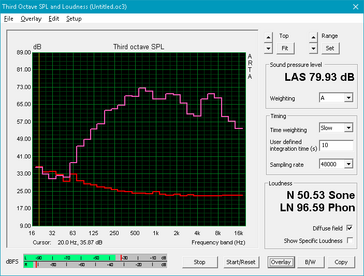
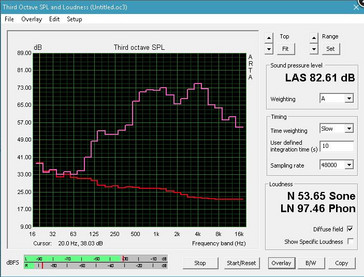
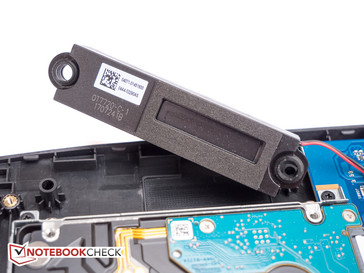
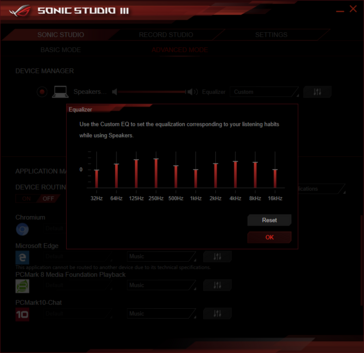
Asus ROG Strix GL702VI-WB74 audio analysis
(±) | speaker loudness is average but good (72.5 dB)
Bass 100 - 315 Hz
(±) | reduced bass - on average 7.5% lower than median
(±) | linearity of bass is average (7.5% delta to prev. frequency)
Mids 400 - 2000 Hz
(+) | balanced mids - only 3.9% away from median
(+) | mids are linear (4.8% delta to prev. frequency)
Highs 2 - 16 kHz
(+) | balanced highs - only 3.7% away from median
(±) | linearity of highs is average (10.4% delta to prev. frequency)
Overall 100 - 16.000 Hz
(+) | overall sound is linear (14.4% difference to median)
Compared to same class
» 25% of all tested devices in this class were better, 6% similar, 69% worse
» The best had a delta of 6%, average was 18%, worst was 132%
Compared to all devices tested
» 14% of all tested devices were better, 4% similar, 82% worse
» The best had a delta of 4%, average was 25%, worst was 134%
Apple MacBook 12 (Early 2016) 1.1 GHz audio analysis
(+) | speakers can play relatively loud (83.6 dB)
Bass 100 - 315 Hz
(±) | reduced bass - on average 11.3% lower than median
(±) | linearity of bass is average (14.2% delta to prev. frequency)
Mids 400 - 2000 Hz
(+) | balanced mids - only 2.4% away from median
(+) | mids are linear (5.5% delta to prev. frequency)
Highs 2 - 16 kHz
(+) | balanced highs - only 2% away from median
(+) | highs are linear (4.5% delta to prev. frequency)
Overall 100 - 16.000 Hz
(+) | overall sound is linear (10.2% difference to median)
Compared to same class
» 5% of all tested devices in this class were better, 2% similar, 93% worse
» The best had a delta of 5%, average was 19%, worst was 53%
Compared to all devices tested
» 3% of all tested devices were better, 1% similar, 96% worse
» The best had a delta of 4%, average was 25%, worst was 134%
Frequency Comparison (Checkbox selectable!)
Graph 1: Pink Noise 100% Vol.; Graph 2: Audio off
Energy Management
Power Consumption
Power consumption is lower than expected across the board considering this is a system without Optimus-technology. While the lower idle power consumption and lower average loads (simulated with 3DMark06) are certainly appreciated, it's interesting to see that the notebook tops out at a paltry 170 W during the stress test. The other laptops in our comparison require at least 80 W more; the Schenker laptop with desktop CPU draws a staggering 180 W more. When running Witcher 3, the GL702VI requires a maximum of 198 W and is thus more in the ballpark for a system with the GTX 1080 GPU. As is, the included 330 W power brick is severely underutilized and a smaller and lighter 250 W power adapter could easily handle the load.
| Off / Standby | |
| Idle | |
| Load |
|
| Asus ROG Strix GL702VI-WB74 i7-7700HQ, GeForce GTX 1080 Mobile, Samsung PM961 MZVLW256HEHP, IPS, 1920x1080, 17.30 | Acer Predator 17 X GX-792-76DL i7-7820HK, GeForce GTX 1080 Mobile, Toshiba NVMe THNSN5512GPU7, IPS, 1920x1080, 17.30 | SCHENKER XMG U727 2017 i7-7700K, GeForce GTX 1080 Mobile, Samsung SM961 MZVPW256 m.2 PCI-e, AHVA, 3840x2160, 17.30 | Alienware 17 R4 i7-7820HK, GeForce GTX 1080 Mobile, SK Hynix PC300 NVMe 512 GB, TN LED, 2560x1440, 17.30 | Aorus X7 v7 i7-7820HK, GeForce GTX 1070 Mobile, Samsung SM961 MZVPW256HEGL, TN LED, 2560x1440, 17.30 | MSI GT75VR 7RF-012 Titan Pro i7-7820HK, GeForce GTX 1080 Mobile, 2x Samsung SM961 MZVPW256HEGL NVMe (RAID 0), TN LED, 1920x1080, 17.30 | Asus G701VIK-BA049T i7-7820HK, GeForce GTX 1080 Mobile, 2x Samsung SM961 MZVPW256HEGL NVMe (RAID 0), IPS, 1920x1080, 17.30 | |
|---|---|---|---|---|---|---|---|
| Power Consumption | -37% | -73% | -47% | -33% | -62% | -39% | |
| Idle Minimum * | 19.8 | 27 -36% | 32 -62% | 37.5 -89% | 27 -36% | 34 -72% | 24 -21% |
| Idle Average * | 25.2 | 32 -27% | 43 -71% | 37.6 -49% | 33 -31% | 41 -63% | 31 -23% |
| Idle Maximum * | 25.9 | 41 -58% | 51 -97% | 37.6 -45% | 40 -54% | 50 -93% | 38 -47% |
| Load Average * | 84.1 | 102 -21% | 138 -64% | 122.4 -46% | 107 -27% | 106 -26% | 98 -17% |
| Witcher 3 ultra * | 198.6 | 279 -40% | 180.3 9% | 190 4% | 257 -29% | ||
| Load Maximum * | 171.1 | 248 -45% | 350 -105% | 277.4 -62% | 259 -51% | 320 -87% | 320 -87% |
* ... smaller is better
Battery Life
Despite the low powre draw, the battery life is typical for a high-end gaming notebook with powerful hardware - or in other words, it's pretty short, despite the fact that the 3D performance takes a severe hit when the notebook is taken of the mains. The GL702VI comes with a 88 Wh battery and lasts about 3.5 hours during the WLAN test, which is a decent enough result. The Schenker XMG U727 with desktop processor quits 40 minutes sooner. Interestingly enough, the Alienware 17 R4 also trails the review notebook by about half an hour - despite the fact that it's equipped with a larger 99 Wh battery.
| Asus ROG Strix GL702VI-WB74 i7-7700HQ, GeForce GTX 1080 Mobile, 88 Wh | Acer Predator 17 X GX-792-76DL i7-7820HK, GeForce GTX 1080 Mobile, 88.8 Wh | SCHENKER XMG U727 2017 i7-7700K, GeForce GTX 1080 Mobile, 89 Wh | Alienware 17 R4 i7-7820HK, GeForce GTX 1080 Mobile, 99 Wh | Aorus X7 v7 i7-7820HK, GeForce GTX 1070 Mobile, 94 Wh | MSI GT75VR 7RF-012 Titan Pro i7-7820HK, GeForce GTX 1080 Mobile, 75 Wh | Asus Strix GL702VSK i7-7700HQ, GeForce GTX 1070 Mobile, 76 Wh | Asus G701VIK-BA049T i7-7820HK, GeForce GTX 1080 Mobile, 93 Wh | |
|---|---|---|---|---|---|---|---|---|
| Battery Runtime | 1% | -18% | -21% | -22% | -37% | -11% | -1% | |
| Reader / Idle | 384 | 313 -18% | 222 -42% | 276 -28% | 221 -42% | 182 -53% | 306 -20% | 342 -11% |
| WiFi v1.3 | 209 | 251 20% | 168 -20% | 181 -13% | 180 -14% | 144 -31% | 203 -3% | 241 15% |
| Load | 89 | 90 1% | 97 9% | 69 -22% | 81 -9% | 65 -27% | 81 -9% | 83 -7% |
Pros
Cons
Verdict
Overall, the Asus ROG Strix GL702VI is a pleasant enough gaming laptop with not too many obvious shortcomings. While we certainly can't overlook that the fact that the system doesn't quite reach its full potential - Asus seems to err on the side of caution in this case when it comes to temperature management - we'd rather give up a few percentage points in performance then having to deal with a system tethering on the verge of overheating at all times. That said, Asus could certainly tweak the fan management with a firmware update and address the issue with the cycling fan speed at the same time, as this behavior can really get quite annoying after a while. Screen bleeding is also an problem, but might be isolated to our test unit.
Although the Asus ROG Strix GL702VI is equipped with high-end components, it falls a bit short when it comes to raw performance.
The keyboard is good enough for longer typing sessions, the palm rests remain cool at all times, and the port selection is adequate. Gameplay is smooth thanks to the combination of a high-end Nvidia GeForce GTX 1080 with a 120 Hz G-Sync Full HD IPS display and should satisfy most for some time to come. Users looking to push their hardware to the extreme need to look elsewhere, but otherwise the Strix GL702VI is decent and fairly inexpensive choice.
Asus ROG Strix GL702VI-WB74
-
02/14/2018 v6(old)
Bernhard Pechlaner


 Deutsch
Deutsch English
English Español
Español Français
Français Italiano
Italiano Nederlands
Nederlands Polski
Polski Português
Português Русский
Русский Türkçe
Türkçe Svenska
Svenska Chinese
Chinese Magyar
Magyar